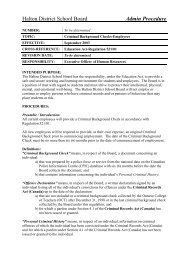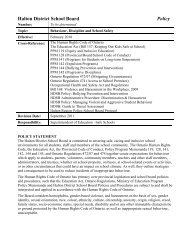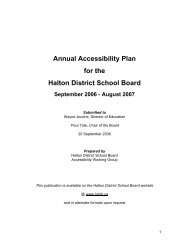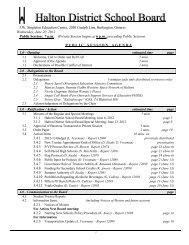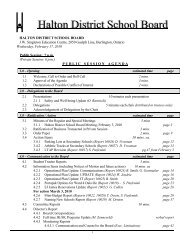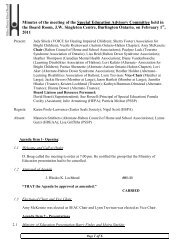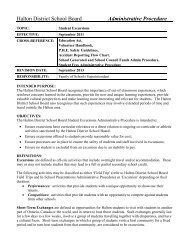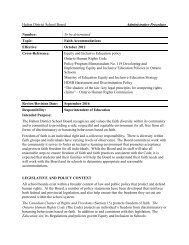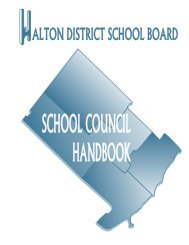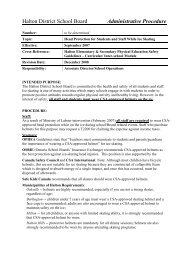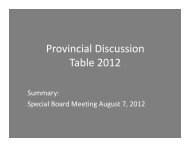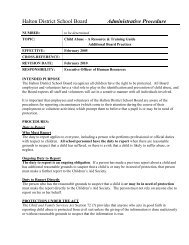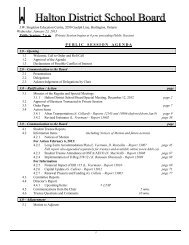hdsb bipsa 2012-2013 - Halton District School Board
hdsb bipsa 2012-2013 - Halton District School Board
hdsb bipsa 2012-2013 - Halton District School Board
You also want an ePaper? Increase the reach of your titles
YUMPU automatically turns print PDFs into web optimized ePapers that Google loves.
Resources<br />
If we use the following resources we will make progress towards the<br />
achievement of our actions and goals. These resources will support the goals of<br />
Literacy, Numeracy, Safe & Inclusive <strong>School</strong>s and Pathways for every student.<br />
• HDSB Reading brochure –Every Student Can Learn to Read<br />
• HDSB PM Benchmark/DRA Administration Cards<br />
• The Art of Guided Reading (HDSB video)<br />
• Literacy Place (primary), Literacy In Action (junior), Nelson<br />
Literacy (intermediate), Envol (primary), Litteratie en Action<br />
(4-8)<br />
• HDSB resource – Linking Literacy Place and EQAO<br />
• HDSB resource – Linking Literacy in Action and EQAO<br />
• RAZ kids (primary reading on-line resource)<br />
• Book Flix<br />
• Book Flood (Independent Reading Texts ENG 1P/1L/2P/2L)<br />
• E-Learning/Blended Learning courses<br />
• Multi-cultural Collection (FDK CHATT conference)<br />
• Lexia Program (self-contained LD classes)<br />
Ministry<br />
• Guides to Effective Literacy Instruction (primary, junior)<br />
• Primary Reading Discussion Paper (webcast)<br />
• eWorkshop (primary/junior English; primary French Immersion)<br />
• Literacy GAINS (Grades 7 – 12)<br />
• Think Literacy Library (Grades 7 – 12)<br />
• Adolescent Literacy Guide<br />
• A Guide to Reflective Practice (Core French)<br />
• Prologue (French Immersion and extended French)<br />
• Supporting Boys’ Literacy<br />
• Summary of Results and Strategies for Teachers (EQAO Primary<br />
and Junior Divisions)<br />
• EQAO Educator Resources (Gr. 3, 6, 10)<br />
• Reading and Writing with Your Child Parent Resource<br />
Human<br />
• Itinerant Resource Teacher: Assessment (K-2)<br />
• Learning Resource Teachers (K-2)<br />
• Literacy Coaches (9 – 12)<br />
Resources<br />
• Pathways Planner (grades 7 and 8)<br />
• MyBlueprint Education planner<br />
• <strong>School</strong> to Career<br />
• Pathways Program Option Resource<br />
• Guide to Secondary <strong>School</strong><br />
• Pathways, Programs and Initiatives<br />
• <strong>Halton</strong> Industry Education Council (HIEC)<br />
• Integrated Learning in the Classroom<br />
• Integrated Curriculum: Increasing relevance while<br />
maintaining accountability<br />
• Choices into Action<br />
• Student Success Differentiated Instruction Professional<br />
Learning Strategy<br />
LITERACY<br />
Professional Learning<br />
If we participate in the following professional learning we will make progress<br />
towards the achievement of our actions and goals. These learning opportunities<br />
will support the goals of Literacy, Numeracy, Safe & Inclusive <strong>School</strong>s and<br />
Pathways for every student.<br />
• Literacy Institutes for Elementary Teachers – learning series<br />
focused on Running Records, Miscue Analysis and responsive<br />
targeted guided instruction in primary literacy<br />
• Elementary Administrator Literacy Learning Team – series<br />
focused on 13 Parameters: A Literacy Leadership Toolkit to<br />
support administrators in leading literacy in their school<br />
• PM Benchmark/DRA Workshops – administration of diagnostic<br />
assessments<br />
• Learning Resource Teachers (32 schools) – build capacity in<br />
effective literacy instruction/intervention in K-2 classrooms<br />
• Levelled Literacy Intervention Network – implementation sessions<br />
for administrators/LRTs (10 schools) and <strong>School</strong> Program staff<br />
• Study Work Study teachers – ongoing collaborative analysis of<br />
students at work with classroom teachers (primary literacy)<br />
• System Implementation and Monitoring (SIM) Primary Literacy<br />
Networks – focus on the use of data to identify learning needs for<br />
small group instruction (e.g., Running Records, observation of<br />
reading behaviours); the four roles of the literate learner; flexible,<br />
small grouping to differentiate instruction to support student<br />
learning<br />
• System Implementation and Monitoring (SIM) French Immersion/<br />
English networks – co-planning cross curricular big ideas;<br />
implementation of literacy strategies to develop thinking and<br />
accountable talk; teachers will collect and analyse evidence in<br />
assessment for and as learning to inform instruction<br />
• Literacy Coaches (9-12) – collaborative learning, co-planning<br />
and/or co-teaching to inform instructional practices to meet the<br />
needs of students<br />
PATHWAYS<br />
Professional Learning<br />
• Boys’ Writing Achievement and Engagement Inquiry –<br />
Non-fiction reading and writing, Information,<br />
Communication Technology<br />
• 7-12 Inquiry Projects – continued focus on Assessment for,<br />
as and of Learning in-services – focus on student knowing<br />
themselves as learners and building self-efficacy<br />
• Contextualized Learning Professional development<br />
• Teacher training to support skills development (e.g., kiln,<br />
wood shop, NTIP, community connections)<br />
• Classroom health and safety training (e.g., design and<br />
technology)<br />
HDSB <strong>Board</strong> Improvement Plan for Student Achievement (K to Grade 12) Page 14



